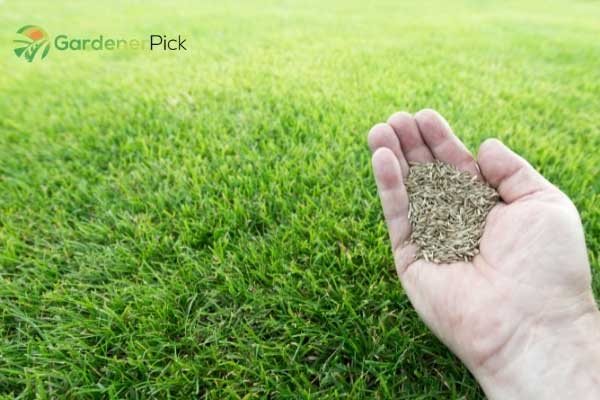Have you purchased a big bag of grass seeds? Have you any idea how to store leftover grass seeds? Are you concerned about the wastage of remaining grass seeds in the package?
If yes, hold on tight. No need to go anywhere else, as we are going to share the best ways to store the grass seeds. Wanna know? Keep on reading.
How to store grass seeds? The grass seeds should be stored at a cool and dry place away from direct sunlight. You can also store these seeds in the refrigerator at a temperature between 40 to 50 °F. A basement, cellar, and a heated shed are also best for storage purposes if the temperature is maintained below 60 to 70°F. Humidity, temperature fluctuations, fungus, and insects are responsible for the spoilage of grass seeds.
If you will store the seeds properly, they will remain viable for the next year or even more. You can easily use them when needed to fill the bare patches or while reseeding your lawn. Normally, the seeds are protected by the mother plant before threshing. During and after being separated from the mother plant, the biotic pressure, temperature, and moisture highly affect the viability and germination of the seeds.
In short, the production environment matters a lot in the long term storage of seeds. Thanks to the online grass seed retailers, they have made the storage easier by delivering the well packed top-quality seeds. After purchasing, it is up to you how you store the seeds.
Table of Contents
Where To Store Grass Seeds
Do you know that storage location matters a lot in maintaining the quality of seeds? So, where should you store grass seeds? The answer is quite simple, you should store the grass seeds in a cool dry place, where the temperature stays between 40 °F to 50 °F. The seeds should not be placed in an area where the temperature drops below 32 °F.
Moreover, the seeds can also be stored in the refrigerator but in this situation, place moisture absorbent to remove extra moisture that may be responsible for seeds spoilage.
The safe places for the grass seeds storage are listed below:
- A heated shed.
- A heated garage.
- A cellar as long as it is dry.
- The dry basement of your house.
- Kitchen Cabinet.
- Refrigerator.
Procedure To Store Grass Seeds
The storage methods of grass seeds for the basement/cellar/shed are different as compared to those in the refrigerator. So, scroll down to read the proper storage procedure.
Storage in the shed/basement/garage/cellar: Before storing the grass seeds, keep the below-mentioned tips in mind:
- If you have an unopened grass seed bag, it is best to keep it in the original package at a cool and dry place like a basement or a cellar. However, if rodents visit your storage place, keep the bag in a rodent-proof container.
- Some of the grass seeds come in breathable bags like a burlap bag or cloth sack. Though the breathable packaging is best as it allows air to flow across minimizing the risk of mold development. But rodents can ruin this packaging, that’s why put it in a rodent-proof jar.
- Make sure that the humidity level of the storage place should be below 60%, and the temperature should be above freezing but below 60 to 70°F. You can use a hygrometer and thermometer to measure the temperature and humidity level. A temperature above 100°F may result in spoilage.
- Avoid storing seeds in areas below freezing temperatures such as unheated garages and sheds, it induces dormancy in the seeds for some time. The internal moisture level of the seeds must be 10 to 20 %. It is necessary for germination. The freezing temperature results in the freezing of this moisture content and seeds can go bad.
- Apply labels on the storage containers and mention the type, brand name, and testing date of the grass seeds. You can use self-sticking labels. The testing date is the time when you have checked the germination rate of a few seeds. Also, make sure to keep the bags or storage containers off the floor.
Storage of Grass seeds in the Refrigerator: You can also store the grass seeds in your refrigerator. No doubt, it can be the best way of storing these seeds. Plus, it also maintains quality but if your refrigerator doesn’t have much space, it is not possible.
However, a small number of seeds can be stored without any space issue. Before storing, read the below-mentioned points:
- Set the temperature of your refrigerator between 40 and 50 °F.
- Don’t place a cloth bag in the refrigerator, as it will absorb moisture.
- If you have an unopened seeds bag, transfer its contents into a sealed container and then store it.
- Placing an open box of baking soda or desiccant will remove excess moisture from the refrigerator.
- Though the seeds will remain fresh for one year, keep on testing the seeds for viability.
Factors Responsible For Ruining Grass Seeds
Mostly, the typical garages and sheds don’t have an ideal atmosphere for storing the seeds. The temperature fluctuations put a bad effect on the viability of seeds. According to a study of Oregon State University, the Kentucky Bluegrass, perennial ryegrass, and tall fescue seeds can germinate 50% if stored for three to five years under favorable conditions. While 50% of the creepy bentgrass seeds can germinate even after 5 years or more if stored properly.
Even the germination rate of the properly stored seeds fall by 10 % every year then you should test the seeds in a small patch before sowing.
There are several factors responsible for the spoilage of grass seeds. Do you wanna know what are these? Just have a look below:
Temperature
Normally, grass seeds have 10 to 20 % of the internal moisture content responsible for successful germination. This moisture will freeze if the seeds are stored below freezing. If the weather is too hot, this moisture will dry out. Similarly, direct sunlight is also bad for seeds. So, the ideal temperature for seeds storage is above freezing and below 100 degrees Fahrenheit.
Humidity
Seeds can absorb moisture in humid conditions. A moisture content greater than 10 to 20 % can spoil the seeds. That’s why storing the seeds in open containers and cloth bags are a bad idea. Such seeds will go stale and are not able to germinate.
Rodents
You may be surprised to know that the biggest enemies of grass seeds are rodents. They can easily drill holes in the breathable packaging or cloth bags of seeds. Any exposure to the moisture can badly affect the seeds. If you want to store the seeds for longer periods, make sure to transfer them into a rodent-proof container. Similarly, galvanized trash cans are best for storing these seeds in the sheds where rodents visit daily.
Insects and Storage Fungi
Mostly the fungi belonging to Aspergillus and Penicillium genre can grow in the seeds even if the moisture content of the storage place is too low. They ruin the seeds by producing toxic substances. It results in the formation of dead tissue inside the seeds. The saprophytic fungi live in these dead tissues causing deterioration of grass seeds. Similarly, insects like weevils spread really fast and damage the seeds. To get rid of insects, the whole storage place should be cleaned.
How long can grass seeds be stored?
Well, it is the most asked question that how long grass seeds can be stored. In short, the grass seeds can be stored for two to three years. Depending on the storage conditions and type of grass seeds, the germination rate of the stored seeds after one year should be 80 to 85 %. This germination rate will drop after every passing year to about 10 to 20 &. It’s mean that fewer seeds will germinate after every passing year.
If the seeds are stored immediately after harvesting, their lifespan will be more. On the other hand, the seeds stored in the bags are more susceptible to spoilage by moisture exposure and rodents. So, properly stored seeds can be preserved for longer times.
Can grass seeds be stored over winter?
Are you wondering whether grass seeds can be stored over winter or not? The short answer is Yes, they can. The proper temperature management and storage conditions are required to store the grass seeds.
The temperature of the place where you have to store the grass seeds must be below 90 Degrees and above 40 degrees. They will remain best for 18 months with only a smaller change in the germination rate. You can also use these seeds after 18 months but fewer seeds will sprout as compared to the freshly stored batch.
How to know if grass seeds are still good?
Are you curious to know how to check if the stored grass seeds are still good? It is quite simple.
The viability of the grass seeds can be checked by performing the germination test. Although they will not grow like the fresh seeds, you can use them in reseeding or overseeding in larger proportions to enjoy lush green turf grass.
For performing a germination test, have a look at the points below.
- Take a damp paper towel and spread 10 seeds on it.
- Roll the paper towel and place it inside a zipped plastic bag.
- Leave the plastic bag in a bright warm place for one week.
- After one week, open the bag and remove the paper towel.
- Count the seeds that are germinated.
- If 8 seeds are sprouted, it means that the germination rate is 80 %.
- If the number of sprouted seeds is too low, you should avoid using them.
Apart from the germination test, some other visible signs can indicate that seeds are gone bad. These are given below:
- Visible mold growing on seeds.
- Soggy seeds
- Rodents damaged seeds.
- Un pleasant odor in seeds.

Can You Store Grass Seeds In a Hot Garage?
You might be wondering if the grass seeds can be stored in a hot garage or not. The brief answer is, it depends on how hot your garage is. If the temperature of your garage is below 60 to 70 degrees Fahrenheit, you can store. But if the garage is too hot and humid, it will affect the viability of seeds.
Normally, grass seeds retain their properties if stored in a cool and dry place away from direct sunlight, insects, and pests. A small number of seeds can be stored in the refrigerator and the kitchen cabinet. For storage in a hot garage, maintain the temperature first, then preserve the seeds.
Will Grass Seed Grow If You just throw It Down
Have you just thrown the grass seeds on the existing lawn? I think you don’t know the right way of reseeding or overseeding a lawn. By just throwing the seeds over the existing grass may result in the seeds wastage and only a few seeds will germinate.
A little effort can make your lawn lush green. So, avoid just throwing the seeds and follow the proper reseeding guideline mentioned below.
- The best time for reseeding or overseeding is in the spring and fall.
- Moisturize the area where reseeding is required.
- Rake the ground properly so that the seeds are mixed slightly with soil.
- The speed of your seed spreader should be 12 to 16 seeds per 1 square inch.
- Keep the area moist for the next two weeks or until the seeds sprout.
Final Verdict
Here is the end of our informative article. Hopefully, you have well understood how to grow grass seeds.
So, the conclusion is, you can store grass seeds if temperature and humidity levels are maintained accordingly. Improper storage may result in fungus development and insect infestation.
However, properly stored grass seeds can be handy while filling the bare patches and repairing of lawn for the next season.
By following our guidelines, you will surely save the seeds for longer. But, you have to compromise on the germination rate.






